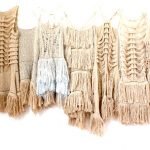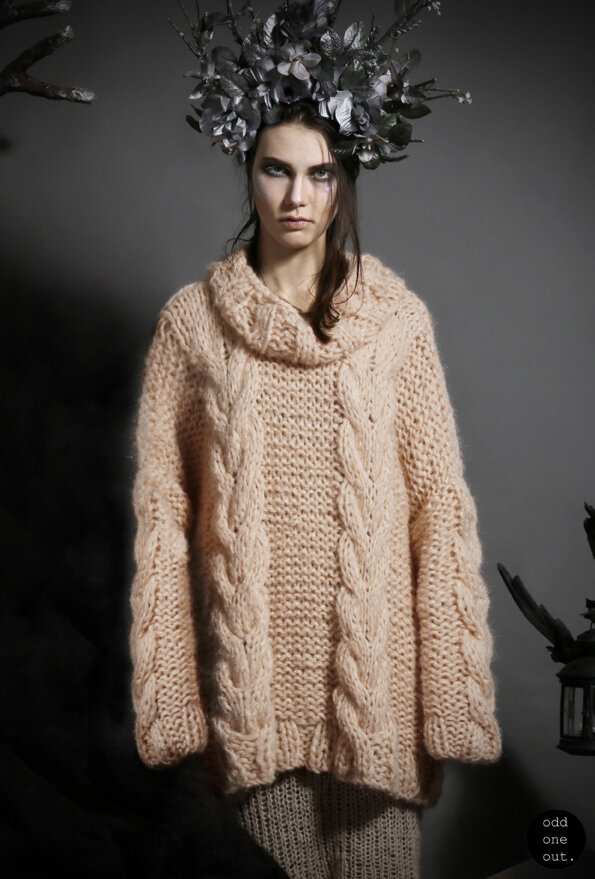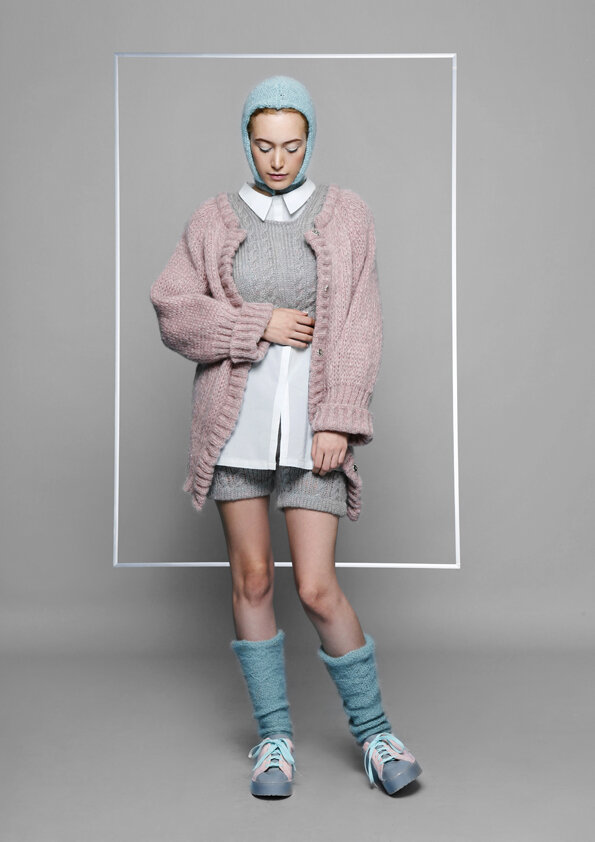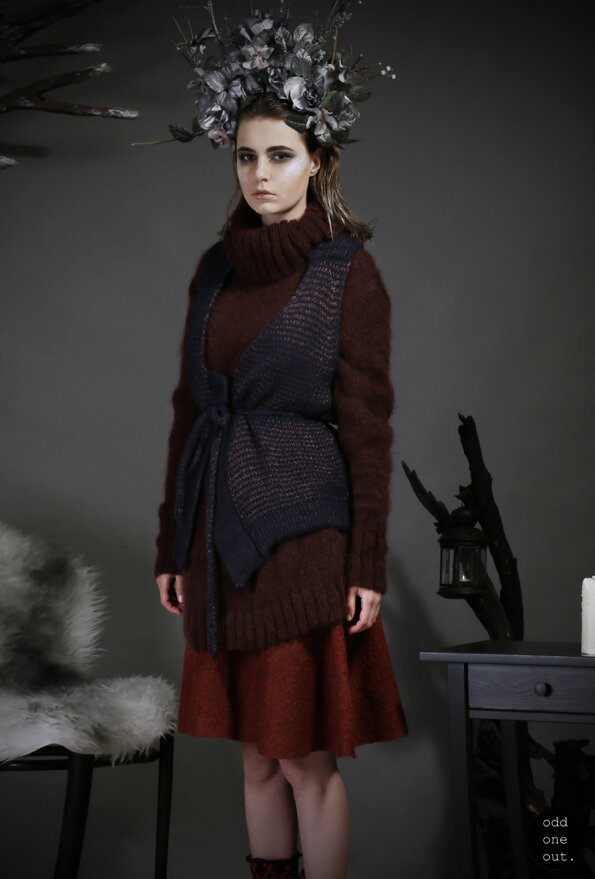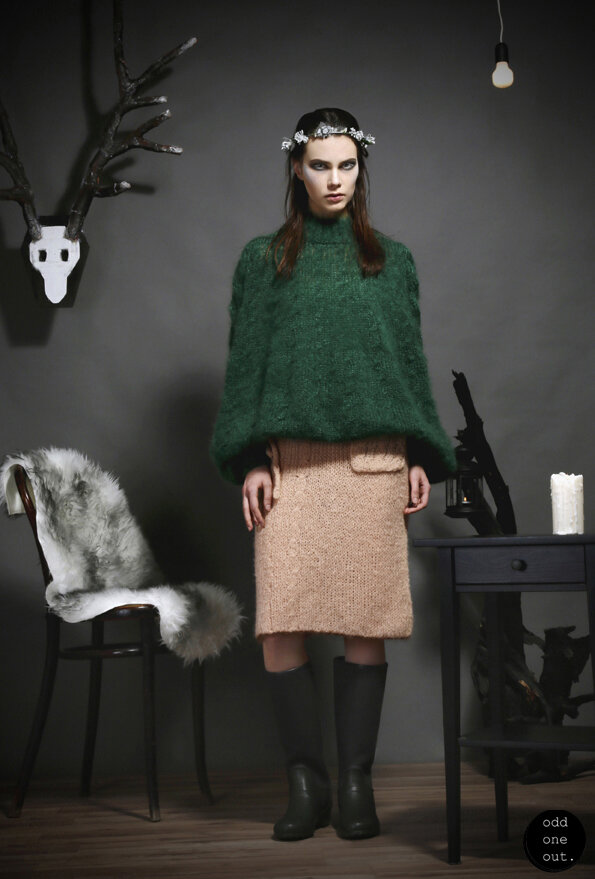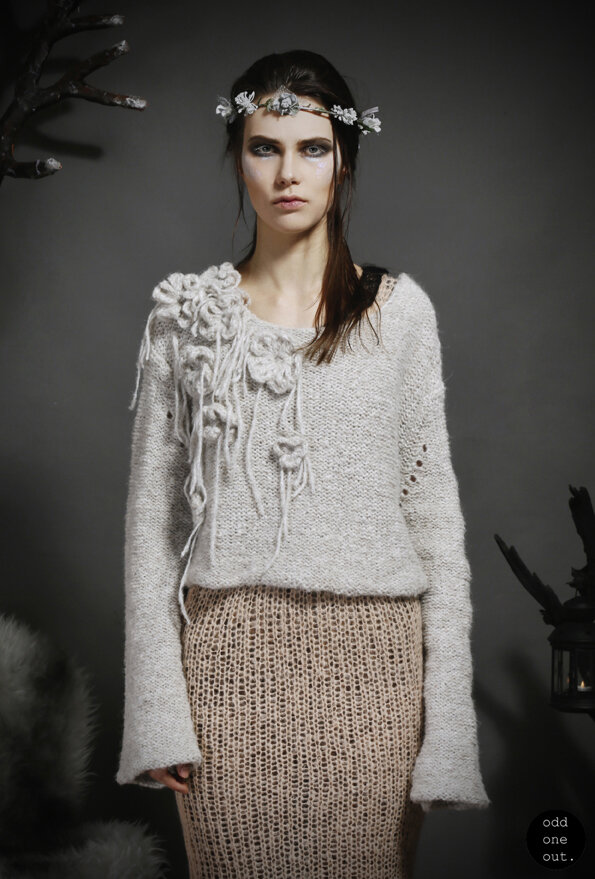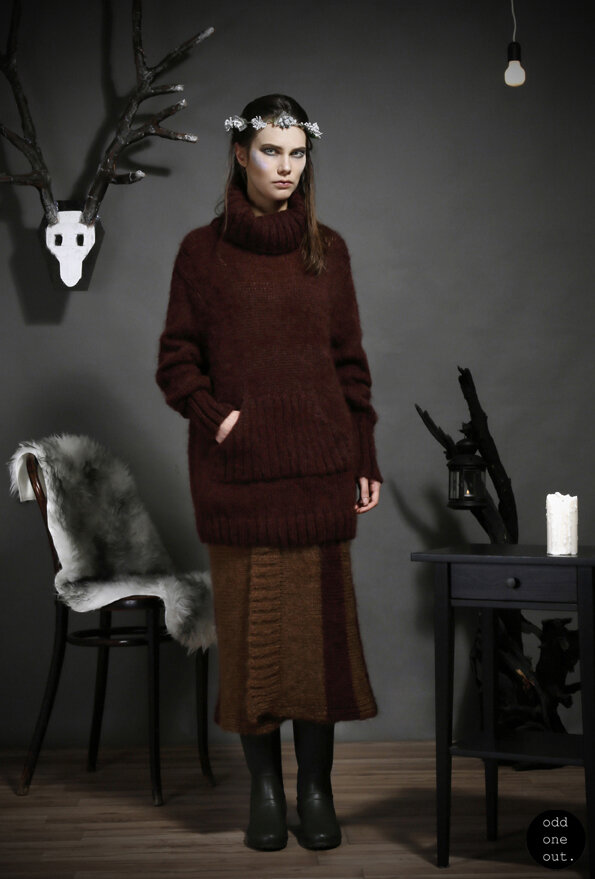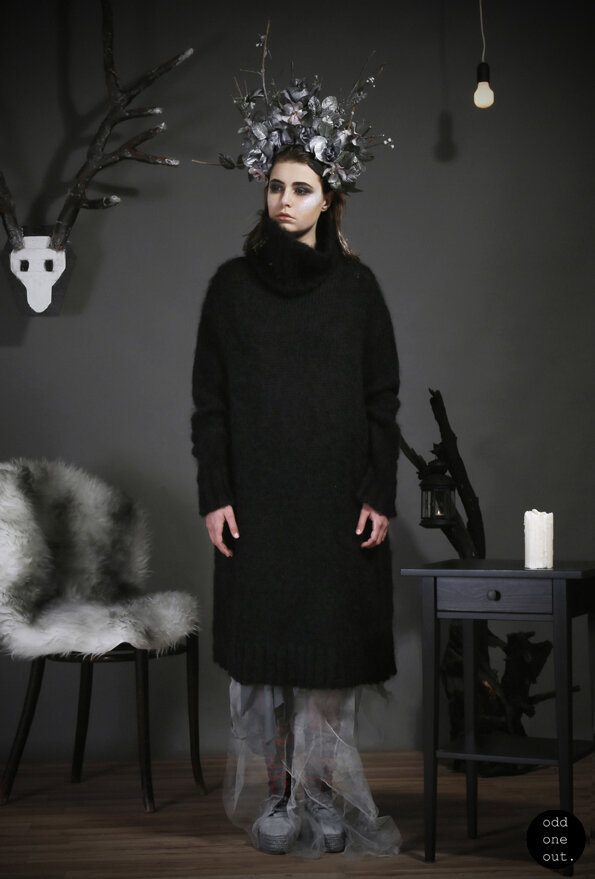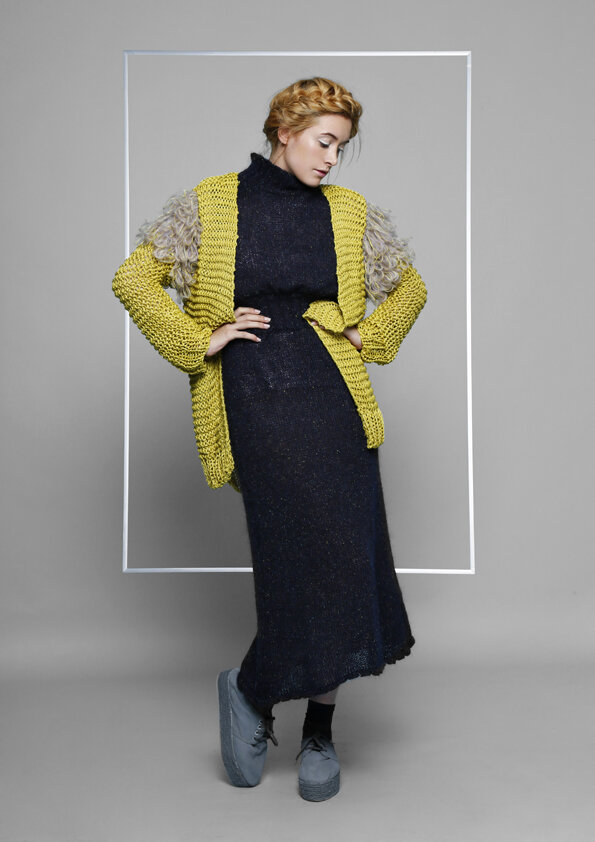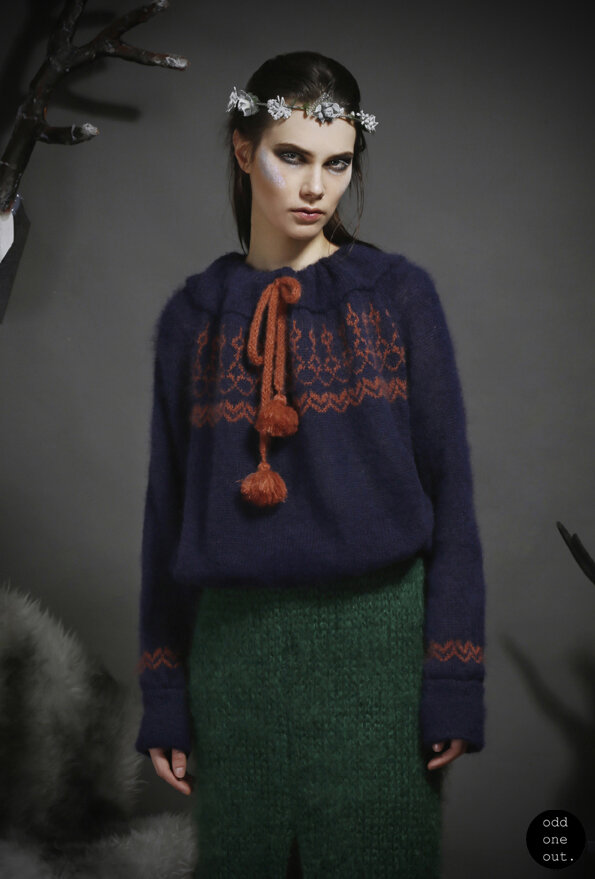World Crafter. Alicia. Barcelona, Spain
World Crafters are people who make things in different parts of the world. Some turned their hobby into a profession, some are balancing a day job with small crafty business, some chose to keep their hobby and just enjoy making, creating and giving. Behind each stitch is a story…
ODD ONE OUT knitwear brand was created by young and talented knitwear designer, Alicia Gonzalez. The brand specializes in artisanal knitwear made with high quality materials carefully handpicked by the designer. The brand's main focus is to create timeless pieces that will last for many years to come. From the computer engineer to the owner of knitwear brand, Alicia's fiber journey is truly inspiring!
What is your first fiber-craft related memory? Do you remember your first stitch?
That’s a good question…I have never thought about it, but I suppose it was a dress for one of my dolls. I cannot remember my first stitch, but I’m sure it was when I was a child with my grandma. She took care of me during the day as my parents worked and she was an expert knitter and crocheter. I have inherited such a nice crocheted quilt. It’s amazing! The truth is I have always loved textile crafts. When I was a child, I remember being at Christmas holidays learning to knit, embroider and cross stitch with my Mum. My first project related to fibers and fabrics was a doll dress. I loved to design and sew dresses for Barbie :)
Before becoming a full time knitwear designer, you were a computer engineer. These two professions are quite different from each other! How did this transition happen? Was it scary for you to make this step or you didn't have any doubts?
I wanted to become a fashion designer since I was 8 years old. I have lots of folders full of "sketches" from that age. When I was a child, I used to spend most of my time drawing and painting dolls. The thing is though I loved all the activities related to art, I also loved Maths and technical subjects. I have always been a real good student.
So, when I got to High School, despite my interest in fashion, art and design, I decided to study a technological baccalaureate. The truth is I felt really divided between two opposite things that I liked. The main reason for that choice was that, as you probably know, in Spain there have always been high unemployment rates, so many people in my surrounding (teachers, friends, family) made me feel that with such studies ("serious studies" as my teachers used to told me), I could have a job/economic security that I could not get through fashion or other artistic activities. Once I entered the university I decided to study Computer Science Engineering because I felt really interested in computers and information society. In my second university year, I decided that I should also go ahead with my "other" me (the artistic one), so I started with Fashion Design studies. In the mornings I was an engineer student and in the evenings I was a fashion design student. Those were hard years of lots of work!!! And many weekends at home instead of going out!!
When I graduated, I started working as an engineer because it’s quite easy to find that kind of job. Furthermore, I have always had in my mind to create my own label, because I would like to transmit not only a look or a garment, I wanted to transmit my way of understanding the world and specially the fashion industry.
My initial idea was to combine my two professional careers; but as an engineer, I wasn’t able to do that, as it took most of my time. On the weekends, I was always working in my atelier with my knitting machines. As the time passed, I felt that I was much more committed to the idea of starting my own knitwear brand. At this time the project I was working on finished and the company asked me to move to another country. That was the moment I decided to change something. It was really scary to make such an important change in my life. It took me a lot of years to change my mind and realize that what I was dedicating most of my time to wasn’t what really made me happy. In my case, as a Computer Science Engineer I got a good job, with stability… but finally, I happily decided I should give a chance to my dream… So here I am!
"…much to my regret, I’m more than 30" – this phrase on your blog really got me! Let me know if I am wrong, but I have a feeling that what you mean by this is that you regret a little bit of not starting your handmade business earlier. If that's the case, do you mind sharing what was stopping you before and what "pushed" you to make this final decision and create your own knitwear label?
Yes and no :) What I really want to say is that I don’t like getting older, I love life and I want to do so many thing in life, that I feel that I would need more lives to do everything I would like to. But in some way, you are also right in your perception. Sometimes I regret not having started earlier because 32 are not like 22. When I was 22, I was not so scary about stability, my economical situation, because you feel it’s the time to take risks and start your "own life"… I feel that 20’s are the perfect age to start a business, because you are young, full of energy and not worried about many things that worry you when you get 30 or 40. Nevertheless, I also feel that now, I’m in a more mature place, that helps me to deal better with many situations that I wouldn’t be able to manage as well as nowadays when I was 20.
You are a hand knitter, machine knitter and a crocheter! Do you have a preference or you are equally fascinated by all of these crafts?
I prefer knitting to crochet. If I have to choose between hand knitting and machine knitting… that would be a difficult choice. Hand knitting is so relaxing, bu at the same time I’m quite an impatient person, so I cannot wait a couple of days or more to see the finished garment, I want to see them right now! On the other hand, machine knitting can be a bit stressful and it’s not so relaxed, but I can see the final garment in just some hours!! I cannot choose, it depends on the moment and the piece.
Before founding "ODD ONE OUT", you did the internship with MANGO Knitwear Quality Assurance. I can only imagine how fascinating it was! You mention that because of this experience, you discovered your true passion – knitting. Do you mind sharing a little bit about this experience – what were your responsibilities there and what did you learn during this time? How does the process of big, mass product knitwear production as MANGO differ from a small handmade knitwear company?
I have always loved knitwear and I specialized in it in my fashion studies, but it was when I was at MANGO that I really realized it was my passion. I came to the conclusion that I love knitwear design because I can combine design with an important technological background. And, at the same time, that’s why not many fashion students are interested in knitwear design. Designing knitwear can be the most creative experience, but at the same time, it needs a high technical background from the designer as you have to know how knitting machines work to get what you have designed.
In the Knitwear Quality Assurance Department, we had to control and ensure the quality of the garments in terms of garment finishes, yarn quality, measurements... As you may know, MANGO produces all their garments outside their offices, so our work was to validate prototypes. In general, in a fashion industry, a Quality Assurance Department is provided with technical sheet from the design team. That sheet gives all the information about the garment: a sketch, description, measurements… Once the prototype arrived from the producer, we had to check and confirm that what the producer knitted was what the designers asked for in terms of measurements, quality, colour, yarn…
I learnt so much during this stage!! Specially about knitwear technical aspects related to production and machines. It differs a lot from a small handmade knitwear brand because in my brand, I’m the designer, the knitter, the pattern maker, the quality assurance department, the sales department... I play all the roles, whereas in such a huge company like MANGO, you are a gear’s part and not the whole part. It was after my internship, that I bought my first domestic knitting machines, I soon needed to know more and more about them.
You are creating your beautiful knitwear pieces with gorgeous fiber! One of the most important things for you, as I understand, is not only the quality of materials, but also where it comes from. Do you mind telling us about the process of choosing the fiber for your collections? You mention that you also use "dead stock" yarns. I think it is absolutely amazing! Could you, please, tell my readers what "dead stock" means and why it is important to put it in use?
Yes, I like to work with high quality materials. I’m especially in love with mohair and alpaca. I try to work with providers who take special care of environment, worker’s conditions… Most of my yarns are produced in Italy and the companies are under #DETOX Greenpeace project, working in a textile industry free of so many pollutant chemical products.
Choosing yarns and fibers for my collections is a hard process, because I like all. I receive lots of mohair shade cards with hundreds of colours, I cannot choose just one!! I fall in love with all of them. I choose colours depending on the collection’s concept. Yes, many times I try to work with dead stock yarns although it is not always possible.
Dead stock yarns are yarns which are no longer used by the fashion industry because they think they are no longer trendy or desirable. For example, imagine Pantone forecasts that next AW17/18 pink is going to be the most trendy colour. That means that most yarns providers will produce lots of yarns in many pink variations and you will see many pink garments on shops. So the following year, Pantone forecasts that in AW18/19, pink is no longer a trendy colours. All that would result in levels of pink yarns stock.
Using dead yarn stock would mean using that pink yarns, which are no longer desirable for the rest of the fashion industry because they consider pink is no longer fashionable and people would not buy pink garments. It’s like giving a second life to a product which is in perfect condition but humanity deliberately decides it’s useless.
As I understand you love the fiber/yarn diversity! In your upcoming SS17 collection you are using different plant fibers. And you are also raising a very interesting question – why knitwear should be associated only with cold season and wool? Do you mind telling us about the fibers you are going to use for SS17 and what advantages/disadvantages do plant fibers have compared to wool?
In my next SS17 I work with cotton. You have to consider that Spain is a really hot country in summer, so knitwear is not a real preference for summer :) In general, people associate knitwear with wool, and it’s not always like that. Using linen or cotton is the only way Spanish people can wear a knitwear piece in the middle of August! The main difference between cotton and wool is perspiration. Plant fibers help us with perspiration, that’s why they are especially good for summer clothing. On the other hand, wool protects us from cold, that’s why is a common winter fiber.
You are from beautiful Barcelona. From what I can say, knitting/crochet is definitely making a come back in Spain. Am I right? Do you feel like people became more interested in fiber work over the last years? Tell us a little bit, please, about your city. Is it a creative city? Are you inspired by it? Do you have your favorite yarn spots?
Well… it’s true that it is coming back a little, but it cannot be compared to other countries. There’s a lot of ignorance about knitting and knitwear. I think the main reason for that is weather. I think knitting is mostly a winter hobby. When you think about winter in Sweden it’s not like when you think about winter in Spain. What I mean is that in Spain, winter it’s like spring in other countries :) You can go out or do many other outdoor activities because we are not at -10ºC and with 50cm snow. I think all that affects in 2 ways:
- Knitting is mostly associated with wool, and in Spain most of people don’t really need huge wool sweaters.
- Our weather conditions allow us to do more outdoor activities, so we don’t have as many indoor hobbies as in other countries.
I think that in general happens in all the Mediterranean countries.
Yes, I think Barcelona is a really creative city because of its connection with the Mediterranean and its proximity to France and the rest of Europe. I’m not usually inspired by Barcelona for my collections, but I think I’m much more open-minded thanks to Barcelona. Barcelona is a very touristic city so we have so many different cultures that it’s impossible that not to connect with them. My favourite yarn spot in the city is my atelier, full with the yarns I love.
Your AW1617 collection (which looks so cozy!!) is inspired and hugely influenced by Icelandic folklore. How did you become interested in Iceland and its history and people? What attracts you in this culture which is pretty different from Spanish one?
As I mention in my blog post, I’m in love with Nordic countries and culture. I have always dreamed about moving to them. I like them so much because of their landscapes and nature. Their lakes, huge trees, snow and their winter! I feel like I would be knitting all the time there, their landscapes are so inspiring… In Barcelona there’s no snow, and almost no winter, so I miss it. I hate summer, hot weather and I don’t like the beach, so I guess that helps to be so in love with them :) I love their simplicity (less is more) and how much they value their crafts and traditions. I think they’ve managed to find a perfect balance between modernity and tradition. I would like a future like theirs for my country. I’ve been to Sweden, Norway and last year in Iceland. It amazed and inspired me so much, that I had to dedicate a whole collection to it.
What "gifts" did you get from your craft?
In my case, the most important gift I could have: happiness.
Dear Alicia, thank you so much for sharing your fascinating and inspiring story and beautiful knitwear pieces! You can find ODD ONE OUT knitwear at www.theoddoneoutdesign.com and on Instagram @the_odd_one_out_design.
Shop ODD ONE OUT knitwear at www.theoddoneoutdesign.tictail.com and OddOneOutDesign Etsy shop.
RELATED POSTS


